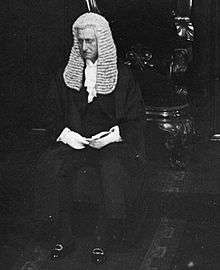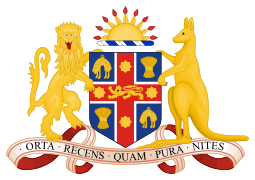President of the New South Wales Legislative Council
The President of the New South Wales Legislative Council is the presiding officer of the upper house of the Parliament of New South Wales, the Legislative Council. The presiding officer of the lower house is the speaker of the Legislative Assembly. The role of President has generally been a partisan office, filled by the governing party of the time. As of May 2017 the president is John Ajaka.
| President of the New South Wales Legislative Council | |
|---|---|
| Style | The Honourable Mr / Madam President (in the Council) |
| Appointer | The Monarch's representative at the behest of the Legislative Council |
| Term length | Elected at start of each Parliament |
| Inaugural holder | Sir Alfred Stephen |
| Formation | 20 May 1856 |
| Deputy | The Hon. Trevor Khan, MLC |
Election
The president is elected by the Council in a secret ballot. The Clerk of the Council conducts the election. The Presidency has always been a partisan office and the nominee of the government party has nearly always been elected—although this cannot be guaranteed since the government of the day does not necessarily have a majority in the Council. The president is assisted by an elected deputy president. The traditional practice has been that the government nominates an MLC to be elected as President, and the Opposition nominates an MLC to be Deputy President. However, as with now, this is not always the case.
Impartiality
The president has a casting vote (in the event of an equality of votes). Like the speaker, the president continues to attend party meetings, and at general elections stands as a party candidate. On the other hand, the president does not usually take part in debates in the Council and does not speak in public on party-political issues. He or she is expected to conduct the business of the Council in an impartial and dignified manner.
Section 22I of the NSW Constitution states that "All questions arising in the Legislative Council shall be decided by a majority of the votes of the Members present other than the President or other Member presiding and when the votes are equal the President or other Member presiding shall have a casting vote."
Role
The president’s principal duty is to preside over the Council, although he or she is assisted in this by the deputy president and a panel of acting deputy presidents, who usually preside during routine debates. The occupant of the chair must maintain order in the Council, uphold the Standing Orders (rules of procedure) and protect the rights of backbench councillors. The president, in conjunction with the speaker of the Legislative Assembly, also administers Parliament House, Sydney, with the assistance of administrative staff.
Although the president does not have the same degree of disciplinary power as the speaker does, the Council is not as rowdy as most Australian legislative chambers, and thus his or her disciplinary powers are seldom exercised.
Perquisites and ceremony

Following the Westminster tradition inherited from the House of Lords of the United Kingdom, the traditional dress of the speaker includes components of Court dress such as the black silk lay-type gown (similar to a Queen's Counsel gown), a wing collar and a lace jabot or bands (another variation included a white bow tie with a lace jabot), bar jacket, and a full-bottomed wig.
The dress of speakers has often variated according to the party in power, but is determinate on the personal choice of the speaker. Most Labor party presidents eschewed the wig while retaining the court dress, while conservative and independent speakers tended to wear the full dress.
The president, currently, no longer wears the full traditional court dress outfit. Max Willis (1991-1998) was the last president to do so. From 1998 to 2011, all the presidents opted not to wear any dress at all, preferring normal business attire. However, upon his election, President Harwin returned to tradition by wearing the gown during question time and on significant occasions such as the Opening of Parliament. However, there is nothing stopping any given speaker, if they choose to do so, from assuming traditional court dress or anything they deem appropriate.
List of presidents of the Legislative Council
| # | President | Party affiliation | Term start | Term end | Time in office |
|---|---|---|---|---|---|
| 1 | The Hon. Sir Alfred Stephen | None | 20 May 1856 | 28 January 1857 | 253 days |
| 2 | The Hon. John Plunkett | None | 29 January 1857 | 6 February 1858 | 1 year, 8 days |
| 3 | The Hon. Sir William Burton | None | 9 February 1858 | 10 March 1861 | 3 years, 29 days |
| 4 | The Hon. William Wentworth | None | 24 June 1861 | 10 October 1862 | 1 year, 108 days |
| 5 | The Hon. Sir Terence Murray | None | 14 October 1862 | 22 June 1873 | 10 years, 251 days |
| 6 | The Hon. Sir John Hay | None | 8 July 1873 | 10 January 1892 | 18 years, 186 days |
| 7 | The Hon. Sir John Lackey | None | 26 January 1892 | 23 May 1903 | 11 years, 117 days |
| 8 | The Hon. Sir Francis Suttor | Progressive | 23 May 1903 | 4 April 1915 | 11 years, 316 days |
| Liberal Reform | |||||
| 9 | The Hon. Frederick Flowers | Labor | 27 April 1915 | 14 December 1928 | 13 years, 231 days |
| 10 | The Hon. Sir John Peden | Nationalist | 5 February 1929 | 22 April 1946 | 17 years, 76 days |
| United Australia | |||||
| Liberal | |||||
| 11 | The Hon. Ernest Farrar | Liberal | 30 April 1946 | 16 June 1952 | 6 years, 47 days |
| 12 | The Hon. William Dickson | Labor | 18 August 1952 | 22 May 1966 | 13 years, 277 days |
| 13 | The Hon. Sir Harry Budd | Country | 9 August 1966 | 5 November 1978 | 12 years, 88 days |
| 14 | The Hon. Johno Johnson | Labor | 7 November 1978 | 3 July 1991 | 12 years, 238 days |
| 15 | The Hon. Max Willis | Liberal | 3 July 1991 | 29 June 1998 | 6 years, 361 days |
| 16 | The Hon. Virginia Chadwick | Liberal | 29 June 1998 | 5 March 1999 | 249 days |
| 17 | The Hon. Dr Meredith Burgmann | Labor | 11 May 1999 | 2 March 2007 | 7 years, 295 days |
| 18 | The Hon. Peter Primrose | Labor | 8 May 2007 | 17 November 2009 | 2 years, 193 days |
| 19 | The Hon. Amanda Fazio | Labor | 24 November 2009 | 3 May 2011 | 1 year, 160 days |
| 20 | The Hon. Don Harwin | Liberal | 3 May 2011 | 30 January 2017 | 5 years, 272 days |
| 21 | The Hon. John Ajaka | Liberal | 21 February 2017 | Incumbent | 3 years, 121 days |
Deputy President and Chair of Committees
Originally titled Chairman of Committees, the current style was adopted on 5 May 2004 during the term of the first female holder of the office. Various legal and constitutional amendments to follow this change were made in the Constitution Amendment (Parliamentary Presiding Officers) Act 2014.[1]
| Chairman of Committees | Party affiliation | Term start | Term end |
|---|---|---|---|
| Hon. George Allen | None | 4 June 1856 | 15 January 1873 |
| Hon. Joseph Docker | None | 15 January 1873 | 9 February 1875 |
| Hon. Sir Joseph Innes | None | 9 February 1875 | 16 December 1880 |
| Hon. Joseph Docker | None | 16 December 1880 | 11 December 1884 |
| Hon. William Piddington | None | 17 March 1885 | 25 November 1887 |
| Hon. Archibald Jacob | None | 1 December 1887 | 28 May 1900 |
| Hon. William Trickett | None | 13 June 1900 | 23 July 1912 |
| Hon. Broughton O'Conor | Liberal Reform | 24 July 1912 | 22 April 1934 |
| Nationalist | |||
| United Australia | |||
| Hon. Ernest Farrar | United Australia | 2 May 1934 | 22 April 1946 |
| Liberal | |||
| Hon. Thomas Steele | Country | 30 April 1946 | 11 March 1953 |
| Hon. Ernest Gerard Wright | Labor | 11 March 1953 | 22 April 1967 |
| Hon. Stanley Eskell | Liberal | 2 August 1967 | 6 March 1969 |
| Hon. Thomas McKay | Liberal | 12 March 1969 | 5 November 1978 |
| Hon. Clive Healey | Labor | 8 November 1978 | 22 February 1988 |
| Hon. Sir Adrian Solomons | National | 28 April 1988 | 2 July 1991 |
| Hon. Duncan Gay | National | 3 July 1991 | 10 May 1999 |
| Hon. Tony Kelly | Labor | 11 May 1999 | 29 April 2003 |
| Hon. Amanda Fazio | Labor | 30 April 2003 | 5 May 2004 |
| Deputy President | Party affiliation | Term start | Term end |
| Hon. Amanda Fazio | Labor | 5 May 2004 | 24 November 2009 |
| Hon. Kayee Griffin | Labor | 24 November 2009 | 4 March 2011 |
| Hon. Jenny Gardiner | National | 3 May 2011 | 5 May 2015 |
| Hon. Trevor Khan | National | 5 May 2015 | Incumbent |
Assistant President
| Assistant President[1] | Party affiliation | Term start | Term end |
|---|---|---|---|
| Hon. Fred Nile | Christian Democrats | 28 June 2007 | 7 May 2019 |
| Hon. Shaoquett Moselmane | Labor | 7 May 2019 | 6 April 2020 |
| Hon. Rod Roberts | One Nation | 17 June 2020 | Incumbent |
References
- "Part Ten - Officers of Parliament" (PDF). NSW Parliamentary Record. Parliament of New South Wales. Retrieved 12 April 2020.
